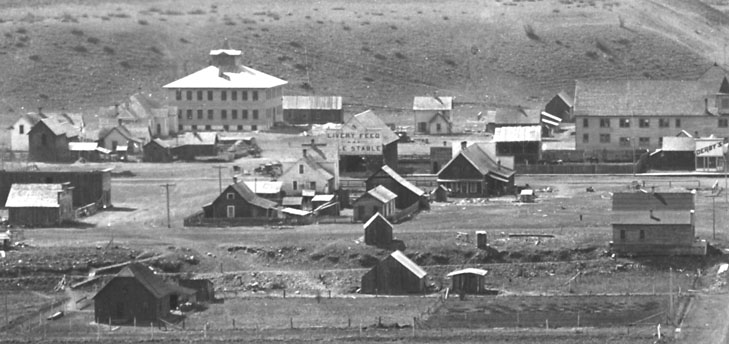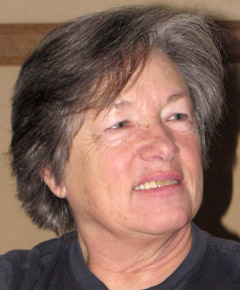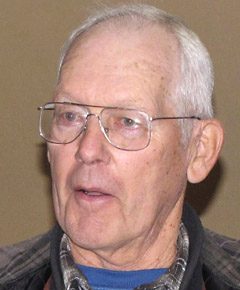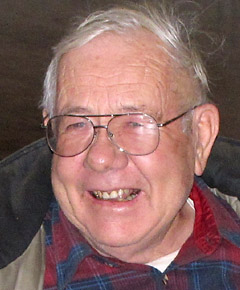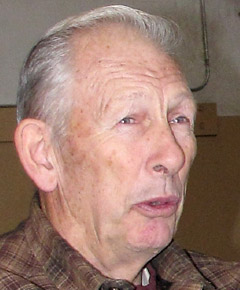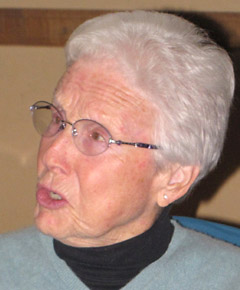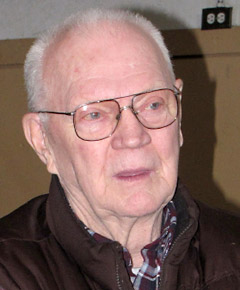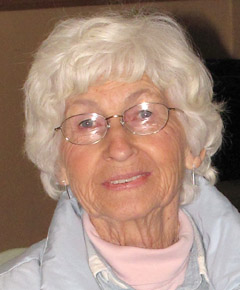The Methow Valley Community Center is throwing itself a year-long birthday party to mark the centennial of the grand old building, which was first occupied on Monday, Jan. 15, 1912. That’s the morning that teachers and students came through the doors of their new eight-room Twisp School building, which included Twisp’s first high school.
There are a book’s worth of tales to be told by the graduates, some of whom met recently to share stories with the Grist. Donna Schulz, class of 1960, organized the gathering. She and others are working on a history of the building as a centennial project.
And, oh, the stories those 100-year-old walls could tell – about the time the boys put a goat in the superintendent’s office above the gymnasium. Or the day a cow tipped over the outhouse, trapping a girl inside. Or the time a huge boulder rolled down the hill behind the school, crashed into the gymnasium and injured Ada “Rae” Roth, who fortunately lived to tell the tale.
“I was looking out the window and saw the rock coming down,” said Bernard Thurlow, class of 1957. “I thought...somebody’s going to get killed here.”
“I was part of it, but I never admitted it,” said Chris Christianson, class of 1951, who went on to explain that he and some other boys had been sent up the hill to clear “loose rock” off what was to become the football field. However, the boulder in question was not very loose. “It took a whole crew up there to get it rolling,” he confessed these many years later.
Christianson was the first to bring up the “goat” incident. He said some boys from the class of 1933 put the goat in the school superintendent’s office. They also turned over all the outhouses in town and somehow got a carriage on the roof of Gibson’s store. “The next day all those boys were taken out of class and put to work putting things back together,” he said.
The girl-in-the-outhouse story was one of Thurlow’s. It seems that in the 1920s his family was running cattle up the Twisp River and the cowboys were having trouble getting one cow over the hill behind the school. One of the Creveling boys was sitting in class and looked out to see the trouble, and since his horse was hitched to the rail outside, he left class and went out to help. Well, the cow hit the outhouse and knocked it over so the door was facing the ground. And there was a girl in the outhouse who was now trapped – a girl the Creveling boy later asked out on a date. “She never would go out with him,” Thurlow said, laughing.
Dave Schulz, class of 1955, said his first day at the Twisp School was quite a shock because he came from the one-room Beaver Creek schoolhouse. But with the help of the older kids he soon fit in. Schulz was a star basketball player in high school, known for his ability to shoot baskets with either hand. And he revealed how that talent came to be. One winter day he was heading to wood shop class (in a building on the present Les Schwab site). Another kid slammed the door and Schulz’s arm went through the glass. Thirty-eight stitches later, there was no way he could play basketball that season. However, while sidelined he taught himself to shoot left-handed. “The first game I came back and scored 20 points against Brewster,” he said grinning.
By the time Schulz was helping fill the sports trophy case, the school building was more than halfway through its 61-year-history as a showpiece of local education. Construction began in 1911 when Peter Jess, a stone worker who had come to the Methow in 1905, and a crew from the town of Methow built the rock and cement foundation. At the same time, bricks for the upper floors were being made from clay dug out of a hillside near the junction of today’s Highway 20 and State Route 153. Otto Hoffman and Peter Filer were the brickmakers, according to a history compiled by Shirley Mantei Schade, who also found that the building cost $12,109.68.
In 1940, a $50,000 addition was built, according to information compiled by Billie Bond Eiffert. The gym, stage, locker rooms, three classrooms, a library, typing room, study hall and a low-pressure heating system were added. The high school was moved to the new classroom wing – today’s Methow Valley Senior Center. But while the school was modernized, the disciplinary tactics of teachers had yet to be reformed.
Carol Filer, class of 1951 and a member of the alumni committee, recalled her trauma in 1946 when she moved to Twisp from Chelan. “I was in the seventh grade and Mrs. [Alpha] Ventzke was my teacher. I did not want to move here. I came under great duress, and so I very reluctantly came to school the first day... Rich Preston was sitting behind me and I turned around to ask him a question, and she came down with this ruler on my hand... She got me on the hand just as hard as she could with that ruler and said, ‘Turn around and shut up.’ I went home and I said, 'I’ll never go back there again. I am going back to Chelan. I am leaving you.' ... I hated her. She was the meanest woman who ever walked this earth – except she was a very good teacher.”
Christianson said Mrs. Ventzke could have “pitched for the New York Yankees.” She could pick up an eraser and hurl it the length of the room, and she bounced erasers and pieces of chalk off the heads of the students she wanted to discipline.
And speaking of old-fashioned discipline, Thurlow said that when his mother was teaching at the school, some kid was giving the principal, a man named Thrasher, a rough time. That principal handed the kid a pair of boxing gloves and he put on a pair and “cold-cocked the kid and that took care of that.” Others also recalled that boys who got in arguments were sometimes made to settle their differences in the boxing ring.
Filer confessed that she and a number of her classmates were expelled from the eighth grade. “All the years before I ever came here, they’d had an eighth grade sneak. And the year I came they decided you couldn’t have an eighth grade sneak so a bunch of us just took [one]... We went down to Mae Eiffert’s and her mother cooked us a chicken dinner and we just went down to the river and had a wonderful time, a wonderful day. But we really paid for it.” To be re-enrolled, they had to have their parents accompany them to school.
Dick Webb, class of 1953, waxed nostalgic about the old days when the school “was part of the town and the town was part of the school. It was like having an giant extra set of parents. It was a beautiful relationship,” he said. Someone else added that back then all the businesses in town closed so everybody could attend school sports events.
Webb, who became a noted studio photographer in Twisp, shared a poignant story about how he got his start in photography. His mentor was Les Bartlett the agriculture class teacher, who built a darkroom in the back of the ag building. Bartlett had just bought a new Speed Graphic camera, Webb said, “a brand new system and it was an event.”
Sadly, Bartlett later drowned in Pearrygin Lake, where he had gone fishing with some buddies in his homemade aluminum boat that lacked air tanks for flotation. His widow called young Webb, who was 14 years old, and said, “Les would want you to have that camera.” One of the conditions was his first assignment – photographing the open-casket funeral service of his beloved mentor.
Over the years Webb made copies of interesting old photographs customers brought him, and in doing so preserved a great deal of valley history.
Another story Webb shared was that there were two Schactschneider kids in his class and that you couldn’t graduate unless you knew how to spell their last name. As if on cue, the group started trying to spell it. But Thurlow protested their spelling. He said the Schactschneider’s dad worked for his dad in the 1930s so he learned early to spell the name, and proceeded to rattle it off for the group.
Thurlow, whose family came to the valley in 1886 when it first opened to white settlement, also said, “I remember being in the hall there when they said President Roosevelt died [April 12, 1945]... Everybody was all shook up about that because the war was still on.”
School lunch is a topic guaranteed to shake stories out of people. The Twisp School lunchroom was called “the dungeon” and was in the basement. Webb said there was no such thing as “road kills” in his day. A dead deer was considered “a hot lunch supply” and the good parts of the meat were fed to the students in whatever creative dish the cook could conjure. He added that Dave Schulz’s mother was such a good school cook she “could create a meal out of a paper sack.”
Loretta Maltais, class of 1957, said that her husband Buzz Maltais loved road-kill deliveries. “They used to get my husband out of class so he could go over to that building they used for the shop and skin 'em.”
She also recalled a painful year of double shifts before the Twisp and Winthrop school districts consolidated. “Your younger kids got on the bus when the older ones got off,” she said. But nobody wanted to give up their local school because everything in the community revolved around the school. But after parents had kids attending two different shifts for a whole school year, Maltais said, “The parents were really sick of it.”
That was not the first year of double shifts. The brick Winthrop School, completed in 1914, was destroyed by an early morning fire on Jan. 1, 1961. Students were sent to all available spaces until new schools could be built and the high school students were sent to Twisp. The rivals had separate classes and different school start times. Someone recalled that the second shift didn’t end until about 6 p.m.
Webb, who served on the school board, said there was a state mandate to consolidate schools wherever possible. Filer added that the state refused to give the Twisp and Winthrop districts money unless they consolidated. And so the class of 1973 was the last to graduate from Twisp. The 61-year-old building was closed and all students moved to consolidated schools south of Winthrop off Twin Lakes Road. The former showpiece of Twisp was boarded up and sat vacant for five years – until a group of citizens set to work on saving it and getting the building restored for a community center, which opened in 1979.
The building still is owned by School District 350. The Methow Valley Community Center pays $1 a year to lease the main building and gymnasium, and the Methow Valley Senior Center pays $1 a year to occupy its wing, which is totally separate. Both organizations pay for their own upkeep, improvement and operating costs. They, along with the Twisp Alumni Association, which held its first reunion in 1979, have raised and spent thousands of dollars over the years to improve and maintain their facilities. And more volunteer hours than anyone could ever compile have brought the building to its centennial celebration. |

